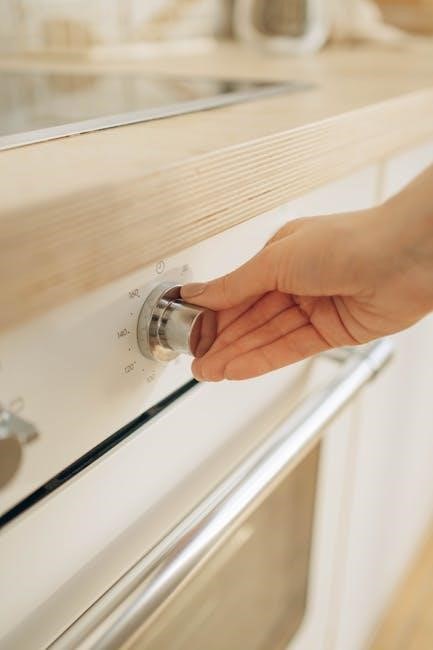Manual lift tables are essential tools designed to elevate and lower loads, enhancing workplace efficiency and safety in various industrial and commercial environments effectively.
1.1 Overview of Manual Lift Tables
Manual lift tables are versatile, ergonomic tools designed to elevate and lower heavy loads, reducing physical strain and improving efficiency in industrial settings. They are commonly used in warehouses, workshops, and production lines to handle materials safely. These tables are typically operated manually or with minimal mechanical assistance, offering a cost-effective solution for lifting tasks. Available in various sizes and load capacities, they are essential for optimizing workflows and ensuring workplace safety across multiple industries.
1.2 Importance of Manual Lift Tables in Industrial Settings
Manual lift tables play a crucial role in enhancing workplace efficiency and reducing physical strain on workers. By eliminating manual lifting, they significantly lower the risk of workplace injuries, ensuring a safer environment. These tables are essential for optimizing workflows, especially in industries where heavy materials or equipment need to be moved frequently. Their versatility and cost-effectiveness make them a necessity in industrial settings, contributing to overall productivity and employee well-being while adhering to safety standards.

Types of Manual Lift Tables
Manual lift tables are categorized into hydraulic, pneumatic, and mechanical types, each offering unique advantages for specific industrial applications and load requirements.
2.1 Hydraulic Manual Lift Tables
Hydraulic manual lift tables operate using hydraulic cylinders, providing smooth and precise load lifting. They are durable, suitable for heavy-duty applications, and offer excellent stability. These tables are commonly used in industrial settings due to their ability to handle large capacities. The hydraulic system ensures controlled movement, minimizing the risk of accidents. Regular maintenance of the hydraulic components is essential for optimal performance. They are ideal for environments requiring reliable and consistent lifting solutions, making them a popular choice in manufacturing and logistics industries.
2.2 Pneumatic Manual Lift Tables
Pneumatic manual lift tables utilize compressed air to raise and lower loads, offering a clean and quiet operation. They are ideal for environments requiring minimal maintenance and no risk of hydraulic fluid leaks. These tables are cost-effective and suitable for lighter-duty applications. Pneumatic systems are often used in food processing and clean rooms due to their non-contaminating nature. However, they rely on a compressed air supply, which may limit their portability. They provide a reliable solution for industries needing efficient, low-maintenance lifting equipment, making them a practical choice for specific industrial and commercial settings.
2.3 Mechanical Manual Lift Tables
Mechanical manual lift tables operate using hand-cranked or lever-based systems, relying on gears and mechanical advantage to lift loads. These tables are durable, low-maintenance, and suitable for environments without access to electricity or compressed air. They are often used in small-scale operations or where simplicity is prioritized. While they require physical effort, mechanical lift tables are reliable and cost-effective, making them ideal for applications with lighter loads and infrequent use. Their straightforward design ensures minimal downtime and easy repair, making them a practical choice for certain industrial and workshop settings.

Design and Construction of Manual Lift Tables
Manual lift tables are designed for durability and functionality, often constructed with steel frames and durable surfaces. Their construction ensures safety, load capacity, and ergonomic operation.
3.1 Key Components of Manual Lift Tables
Manual lift tables consist of a sturdy base, a lifting mechanism, and a work surface. The base provides stability, while the lifting mechanism, such as hydraulics or pneumatics, enables height adjustment. The table top is typically made of durable materials like steel or wood. Additional components include handles or foot pedals for operation and safety features like emergency stops. These elements ensure smooth, efficient, and safe operation, catering to various industrial and ergonomic needs.
3.2 Load Capacity and Weight Limits
Manual lift tables are designed with specific load capacity and weight limits to ensure safe and efficient operation. These limits are determined by the table’s construction and lifting mechanism. Exceeding the maximum load capacity can compromise safety and damage the equipment. Manufacturers typically specify these limits, which vary depending on the table’s design and intended use. Adhering to these guidelines is crucial to prevent accidents and maintain optimal performance. Proper load assessment is essential before operation to ensure compliance with the stated weight restrictions.
3.3 Material and Construction Quality
Manual lift tables are constructed from high-quality materials to ensure durability and reliability. Steel is commonly used for its strength and stability, while aluminum may be employed for lighter-duty applications. The construction process involves precise welding and assembly to maintain structural integrity. Durable coatings, such as powder coating, are often applied to protect against corrosion. The choice of materials and construction methods directly impacts the table’s performance, safety, and lifespan. Investing in well-constructed lift tables ensures long-term functionality and minimizes the risk of mechanical failures during operation.

Applications of Manual Lift Tables
Manual lift tables are widely used in industrial workshops, warehouses, automotive repair shops, aerospace, manufacturing, and healthcare settings to enhance efficiency and reduce manual labor.
4.1 Industrial Workshops and Warehouses
Manual lift tables are essential in industrial workshops and warehouses for efficiently handling heavy loads, reducing manual labor, and enhancing worker safety. They are commonly used for assembly, repair, and storage tasks, allowing workers to lift and position materials at optimal heights. This reduces strain and improves productivity. Additionally, these tables are durable and adaptable, making them suitable for various industrial environments where space and flexibility are critical. Their ability to integrate with other equipment further streamlines workflows in busy industrial settings.
4.2 Automotive Repair Shops
Manual lift tables play a crucial role in automotive repair shops, enabling technicians to handle vehicles and heavy components safely and efficiently. They are used for lifting cars, engines, and transmissions, reducing physical strain and improving workflow. These tables are particularly useful in small or medium-sized shops where space is limited. Their ergonomic design allows for easy positioning, minimizing fatigue and enhancing precision during repairs. Additionally, manual lift tables in automotive settings help maintain organizational efficiency, ensuring tools and parts are within easy reach, thereby streamlining service operations and improving overall productivity.
4.3 Aerospace and Manufacturing Industries
Manual lift tables are essential in aerospace and manufacturing industries for handling large components, tools, and equipment. They provide precise height adjustment, enabling workers to access aircraft parts, machinery, or assembly lines safely. These tables are designed to withstand heavy loads and harsh environments, ensuring durability and reliability. Their stability features prevent accidents, while ergonomic designs reduce worker fatigue. Customizable options allow them to fit specific industry needs, making them versatile for tasks ranging from assembly to maintenance. This enhances productivity and reduces downtime in high-demand manufacturing processes.
4.4 Healthcare and Laboratory Settings
Manual lift tables are invaluable in healthcare and laboratory settings, where precision and sterility are crucial. These tables are used to handle medical equipment, samples, and supplies, ensuring safe and efficient workflows. Their smooth height adjustment minimizes disruptions, while ergonomic designs reduce physical strain on staff. Constructed from easy-to-clean materials, they maintain hygiene standards. In laboratories, they facilitate precise positioning of sensitive instruments, enhancing accuracy. By supporting these environments, manual lift tables contribute to improved patient care and operational efficiency without compromising on safety or cleanliness.

Safety Features of Manual Lift Tables
Manual lift tables incorporate essential safety features to protect users and loads, including emergency stop mechanisms, load sensors, and stable platforms, ensuring secure and reliable operation.
5.1 Safety Standards and Regulations
Manual lift tables must adhere to stringent safety standards and regulations to ensure safe operation and compliance with industry requirements. These include load capacity verification, stability testing, and adherence to international standards like ISO or OSHA guidelines. Regular inspections and certifications by third-party organizations are often mandatory to confirm compliance. Additionally, manufacturers must design lift tables according to specific safety protocols, such as proper load distribution and emergency stop mechanisms, to minimize risks and ensure operator safety in various industrial environments. Compliance with these regulations is critical to prevent accidents and maintain workplace safety standards.
5;2 Emergency Stop Mechanisms
Emergency stop mechanisms are a critical feature of manual lift tables, designed to immediately halt operation in dangerous situations. These mechanisms, such as easily accessible buttons or paddles, allow operators to quickly stop the table’s movement to prevent potential injuries or equipment damage. Regular testing of these mechanisms is essential to ensure reliability and responsiveness. Manufacturers often integrate these safety devices to meet industry standards, providing an additional layer of protection for workers. Their presence enhances overall safety and confidence in the equipment’s performance during daily operations.
5.3 Load Stability and Balance Features
Load stability and balance features are essential for safe and efficient operation of manual lift tables. These features include wide bases, non-slip platforms, and weight distribution systems to prevent tipping. Some tables come with adjustable legs or levelers to ensure stability on uneven surfaces. Additionally, overload protection mechanisms prevent exceeding weight limits, maintaining balance. These designs minimize the risk of accidents and ensure smooth operation, making manual lift tables reliable for various industrial applications. Properly designed balance features also reduce operator fatigue and enhance productivity in demanding work environments. Regular inspections of these components are crucial for sustained safety and performance.

Maintenance and Repair of Manual Lift Tables
Regular lubrication of moving parts, inspection of hydraulic or mechanical components, and timely replacement of worn parts ensure optimal functionality and safety of manual lift tables.
6.1 Regular Maintenance Schedule
Regular maintenance is crucial to ensure the longevity and safe operation of manual lift tables. A daily inspection should include checking for wear and tear on components like hinges, cylinders, and frames. Lubricate moving parts every month to prevent friction and corrosion. Hydraulic systems should be inspected quarterly for fluid levels and leaks. Annual professional inspections are recommended to assess overall integrity and compliance with safety standards. A well-planned maintenance schedule helps prevent unexpected downtime and ensures reliable performance in industrial environments. Consistency in upkeep is key to maintaining workplace safety and efficiency.
6.2 Troubleshooting Common Issues
Common issues with manual lift tables include failure to lift, instability, or hydraulic leaks. If the table won’t lift, check for low hydraulic fluid levels or air in the system. For instability, ensure the table is on a level surface and the load is centered. Leaks in hydraulic lines or cylinders should be inspected and repaired promptly. Regular lubrication of moving parts can prevent stiffness or slow operation. Addressing these issues quickly ensures smooth functionality and workplace safety. Always refer to the manufacturer’s guidelines for specific troubleshooting steps.
6.3 Replacement of Wearable Parts
Regular replacement of wearable parts, such as hydraulic seals, cylinders, and rollers, is essential for maintaining the performance of manual lift tables. Over time, these components can degrade due to heavy use or environmental factors. When replacing parts, ensure they meet the manufacturer’s specifications to guarantee safety and functionality. Always follow proper safety protocols, such as lowering the table fully before starting work. Prompt replacement prevents costly downtime and ensures the table operates efficiently. Adherence to the manufacturer’s guidelines is crucial for a successful replacement process.
Advantages of Using Manual Lift Tables
Manual lift tables offer cost-effectiveness, reliability, and simplicity, enhancing workplace ergonomics while reducing physical strain. They are ideal for light-duty applications, providing efficient material handling solutions.
7.1 Improved Workplace Ergonomics
Manual lift tables significantly enhance workplace ergonomics by reducing physical strain on workers. They eliminate the need for repetitive bending, lifting, and stretching, minimizing the risk of musculoskeletal injuries. By providing an adjustable work surface, these tables ensure tasks can be performed at optimal heights, promoting better posture and reducing fatigue. This leads to increased worker comfort, higher productivity, and improved overall job satisfaction. Additionally, ergonomic design features help streamline workflows, making operations safer and more efficient in various industrial and commercial environments.
7.2 Cost-Effectiveness Compared to Automatic Lifts
Manual lift tables are often more cost-effective than automatic lifts due to their simpler design and lower initial purchase cost. They require less complex engineering, reducing production and installation expenses. With no need for advanced automation or electricity, manual lift tables also lower long-term energy and maintenance costs. This makes them a practical choice for businesses seeking reliable, budget-friendly solutions for material handling. Their durability and minimal upkeep further enhance their cost-effectiveness, providing long-term savings for industries with moderate lifting needs.

Disadvantages of Manual Lift Tables
Manual lift tables require physical effort, reducing efficiency in repetitive tasks. They also have limited load capacity, making them less suitable for heavy-duty applications and industrial needs.
8.1 Limited Load Capacity
Manual lift tables often have restricted load capacities, making them less suitable for heavy-duty applications. Their design typically limits the maximum weight they can handle, which may not meet the demands of industrial settings requiring heavier loads. This limitation can lead to inefficiencies in workplaces where larger or heavier objects need to be lifted frequently. Additionally, exceeding the recommended load capacity can compromise safety and potentially damage the equipment. As a result, manual lift tables are better suited for smaller-scale operations or lighter materials, rather than environments with substantial lifting requirements.
8.2 Physical Effort Required for Operation
Manual lift tables require significant physical effort for operation, as they rely on human power to raise or lower loads. This can lead to operator fatigue, especially in environments where frequent lifting is necessary. The need for manual cranking, pumping, or pushing can strain muscles and increase the risk of workplace injuries. Additionally, repetitive tasks may reduce productivity and efficiency, particularly in fast-paced settings. While suitable for light-duty applications, manual lift tables are less practical in scenarios where automation or powered solutions would alleviate physical strain and improve workflow.

Comparison with Other Types of Lift Tables
Manual lift tables differ from electric or hydraulic models in cost, operation, and maintenance, offering a simple, low-tech solution for light-duty applications with minimal setup required.
9.1 Manual vs. Electric Lift Tables
Manual lift tables are cost-effective solutions requiring physical effort for operation, making them ideal for light-duty applications. In contrast, electric lift tables offer greater lifting capacity and faster operation but come with higher initial and maintenance costs. Manual tables are preferred in smaller workshops or where power availability is an issue, while electric models dominate industrial settings requiring heavy lifting. Both options cater to different needs, with manual tables emphasizing simplicity and electric tables focusing on efficiency and productivity in demanding environments.
9.2 Manual vs. Hydraulic Lift Tables
Manual lift tables rely on physical effort for operation, offering simplicity and lower costs, while hydraulic models use fluid power for smoother, controlled lifting. Hydraulic tables handle heavier loads and reduce operator fatigue but require regular maintenance of hydraulic systems. Manual tables are suitable for light-duty applications, whereas hydraulic tables are ideal for industrial settings with heavy lifting needs. Both options provide efficient solutions, but hydraulic models offer greater precision and power, making them a preferred choice in industries like manufacturing and automotive repair.
9.3 Manual vs. Pneumatic Lift Tables
Manual lift tables operate via physical effort, offering simplicity and portability, while pneumatic models use compressed air for smoother, assisted lifting. Pneumatic tables reduce strain and are ideal for repetitive tasks, but they require an air supply and more maintenance. Manual tables are cost-effective for light-duty applications, while pneumatic tables excel in heavy-duty or clean environments like food processing. Both options are efficient, but pneumatic models provide easier operation for heavier loads, making them suitable for industries requiring consistent and controlled lifting solutions.

Cost Considerations
Manual lift tables vary in cost based on size, load capacity, and features. While they are generally cost-effective, their suitability depends on specific industrial requirements and applications.
10.1 Initial Purchase Cost
The initial purchase cost of manual lift tables varies depending on their size, load capacity, and additional features. Basic models are more affordable, while advanced models with adjustable heights or swivel tops are pricier. Generally, manual lift tables are more cost-effective than automatic or hydraulic alternatives, making them a budget-friendly option for many industries. However, the cost may increase for customized solutions tailored to specific workplace needs. Despite this, they remain a popular choice due to their durability and low upfront investment requirements.
10.2 Long-Term Maintenance Costs
Manual lift tables generally have lower long-term maintenance costs compared to automated or hydraulic systems. Regular lubrication of moving parts and inspections for wear and tear are typically sufficient. However, components like hydraulic seals or pneumatic cylinders may require periodic replacement, adding to maintenance expenses. Despite these costs, manual lift tables are known for their durability and minimal upkeep needs, making them a cost-effective option for industries prioritizing reliability and longevity. Proper maintenance can significantly extend the lifespan of the equipment, reducing overall expenditure over time.

Future Trends in Manual Lift Table Technology
The future of manual lift table technology is expected to focus on integration with smart factory systems and Industry 4.0. Innovations like IoT-enabled tables for real-time monitoring and predictive maintenance are on the horizon. Additionally, there is a growing emphasis on sustainable materials and energy-efficient designs. Ergonomic advancements, such as adjustable height settings and intuitive controls, will likely become standard. Touchless operation and mobile app integration may also emerge, enhancing usability and safety. These trends aim to optimize performance, reduce downtime, and align with modern industrial demands for efficiency and sustainability.
Manual lift tables are essential tools for enhancing workplace efficiency, safety, and ergonomics. Their versatility across industries, from manufacturing to healthcare, highlights their universal appeal. While they offer cost-effective solutions, considerations like load capacity and regular maintenance are crucial. As technology advances, manual lift tables will continue to evolve, blending traditional reliability with modern innovations. Their enduring relevance in industrial and commercial settings underscores their value as indispensable equipment for optimizing workflows and ensuring operational excellence.


























































































